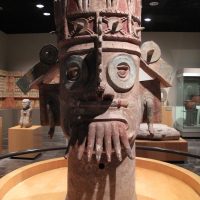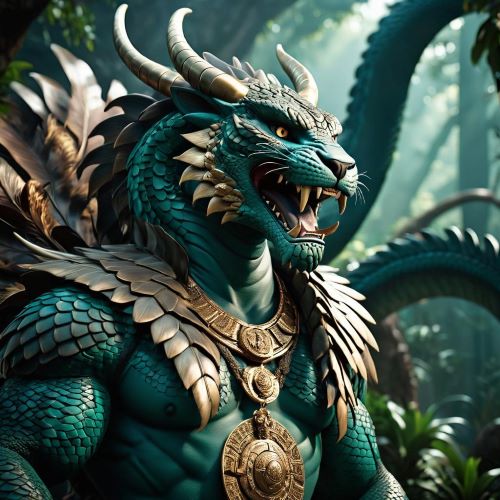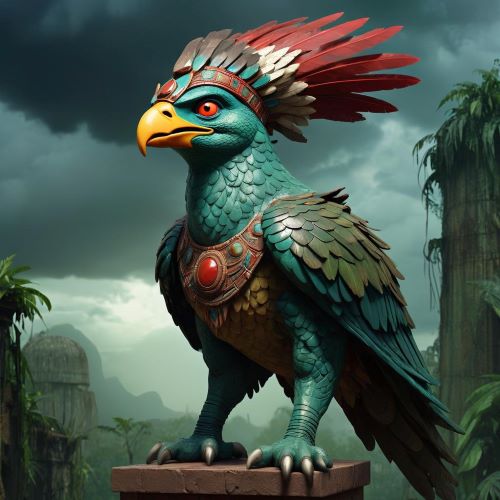Water God : The Hidden One
Listen
At a glance
| Description | |
|---|---|
| Origin | Olmec Mythology |
| Classification | Gods |
| Family Members | N/A |
| Region | Mexico |
| Associated With | Water, Rivers |
Water God
Introduction
The Olmec civilization, flourishing along the southern coast of the Gulf of Mexico from approximately 1200 BCE to 400 BCE, marked the emergence of the first major Mesoamerican civilization. Within their religious beliefs, the Olmecs held reverence for numerous supernatural entities, among which the Water God held a particularly prominent position. Revered for his control over the essential element of water, this deity played a crucial role in Olmec cosmology and spiritual rituals.
Physical Traits
The depiction of the Olmec Water God often embodies a unique amalgamation of characteristics, evoking imagery reminiscent of the Were-Jaguar. This deity is typically represented as a corpulent dwarf or infant, adorned with features such as fiery eyebrows and a bifurcated tongue. While his dominion extends over the realms of water, encompassing rivers, lakes, and various aquatic sources, his portrayal in Olmec art reveals a remarkable adaptability and versatility. Some representations depict him with jaguar-like attributes, suggesting formidable claws and fangs that symbolize the primal forces of nature.
In other depictions, he assumes more humanoid features, embellished with motifs of flowing water or emerging from watery depths. Furthermore, the Water God’s ability to metamorphose is underscored by imagery wherein he merges with creatures like crocodiles or serpents, highlighting his profound connection to the diverse manifestations of the natural world.
Family
Within the Olmec pantheon, a diverse array of deities embodied various facets of the natural and supernatural domains. Among them, the Water God occupied a significant place, frequently partnering with the Maize God in what can be perceived as a divine collaboration. This association between the Water God and the Maize God underscores their mutual importance in Olmec cosmology.
In certain interpretations of Olmec mythology, the Water God assumes an even more profound role as the progenitor of both the earth and sky. This belief highlights the intrinsic generative power attributed to water, which sustains life and facilitates the creation of the fundamental elements of existence. Such interpretations illuminate the deep reverence the Olmecs held for the life-giving properties of water, emphasizing its central role in their spiritual and cosmological worldview.
Other names
The Water God, alternatively known as the Olmec Rain Deity or referred to as God III within scientific discourse, embodies a figure whose precise names and roles have largely faded with time. The absence of a singular, definitive title for this deity adds layers to the enigma surrounding his identity. Some scholars speculate that he may have been equated with figures such as Ah Puch, a deity from later Maya mythology associated with the realms of death and the underworld, suggesting a gradual evolution of religious beliefs across epochs.
Additional epithets associated with the Water God include Chaac, revered as the rain god in Maya tradition, and Tlaloc, the Aztec deity presiding over rain and storms. These varied appellations not only reflect the fluidity of religious concepts within Mesoamerican cultures but also underscore the interconnectedness and shared mythological roots across diverse civilizations of the region.
Powers and Abilities
The Olmec Water God held a paramount position within the ancient Mesoamerican civilization of the Olmecs. This deity, intimately linked with the essential natural phenomenon of rainfall, played a pivotal role in ensuring agricultural abundance, vital for sustaining their livelihoods. The Olmecs perceived the Olmec Rain God as the arbiter of precipitation, wielding the power to bestow either prosperity or drought upon the land.
Moreover, the Water God’s association with caves and cenotes, natural wells believed to serve as portals to the underworld, underscores his deep connection to the cyclical rhythms of life, death, and regeneration. Depictions of the deity often feature maize symbols, emblematic of his pivotal role in agricultural fecundity and the sustenance of the Olmec populace.
Modern Day Influence
The impact of Olmec religious beliefs extended well beyond the confines of their civilization, leaving an indelible mark on the spiritual traditions of subsequent Mesoamerican cultures. Through mechanisms such as trade, cultural interchange, and population movements, the religious ideologies and symbolic imagery of the Olmecs diffused across neighboring societies, shaping their own religious frameworks.
Even today, the legacy of the Olmec civilization reverberates in the religious practices and mythologies of later pre-Columbian cultures. This enduring influence is particularly evident in the veneration of rain deities within Mesoamerican civilizations, ranging from the Maya reverence for Chaac to the Aztec adulation of Tlaloc.
Furthermore, the Water God’s association with concepts of water, vitality, and fertility continues to resonate in contemporary indigenous communities throughout Mexico and Central America. Rituals and ceremonies dedicated to honoring the life-sustaining essence of water serve as a testament to the enduring significance of Olmec religious traditions.
Related Images
Frequently Asked Questions
What is lorem Ipsum?
I am text block. Click edit button to change this text. Lorem ipsum dolor sit amet, consectetur adipiscing elit. Ut elit tellus, luctus nec ullamcorper mattis, pulvinar dapibus leo.
What is lorem Ipsum?
I am text block. Click edit button to change this text. Lorem ipsum dolor sit amet, consectetur adipiscing elit. Ut elit tellus, luctus nec ullamcorper mattis, pulvinar dapibus leo.
What is lorem Ipsum?
I am text block. Click edit button to change this text. Lorem ipsum dolor sit amet, consectetur adipiscing elit. Ut elit tellus, luctus nec ullamcorper mattis, pulvinar dapibus leo.
What is lorem Ipsum?
I am text block. Click edit button to change this text. Lorem ipsum dolor sit amet, consectetur adipiscing elit. Ut elit tellus, luctus nec ullamcorper mattis, pulvinar dapibus leo.
What is lorem Ipsum?
I am text block. Click edit button to change this text. Lorem ipsum dolor sit amet, consectetur adipiscing elit. Ut elit tellus, luctus nec ullamcorper mattis, pulvinar dapibus leo.









